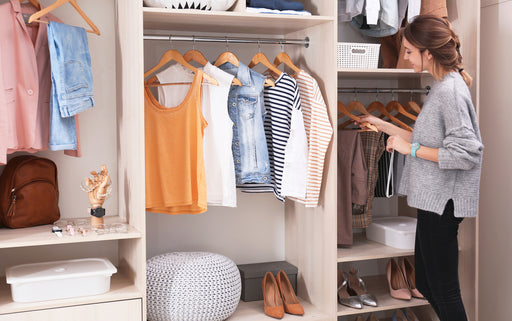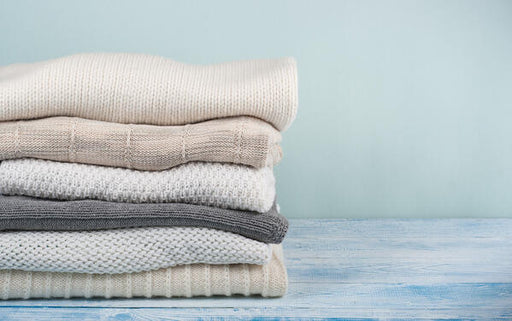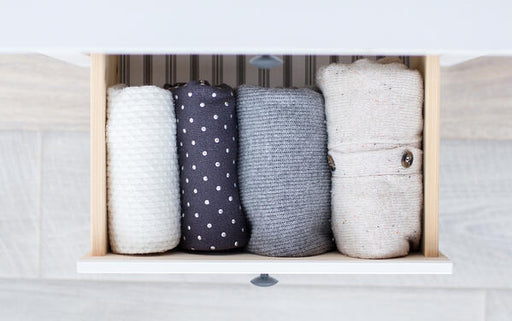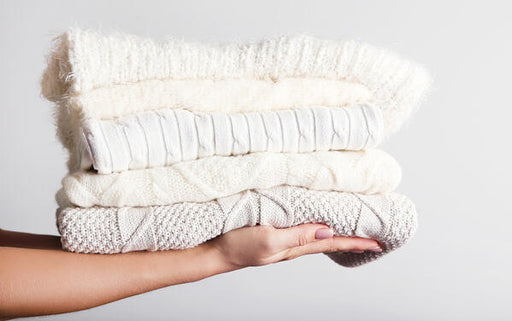How To Organize a Closet

There are several reasons for wanting to learn how to organize a closet, chief among them the convenience they offer you when you're getting ready for the day. Equally important is the way in which a clean, tidy closet helps you preserve your best pieces for years of wear. Follow this guide to evaluate your closet organization and the way you use your space, store your clothes and prevent mess and damage for the long-term.
Start with a Clean Slate and a Clean Closet
Every closet should be thoroughly cleaned at least a few times a year. It's best to do this as the seasons change since it's most likely to coincide with major changes in your wardrobe plans for the next few months. This kind of deep cleaning can take some time, so it's best to plan it for a day when you can dedicate a few hours to completing the task from start to finish. Brainstorming some closet organization ideas can help too!
If you can't manage an entire closet clean-out in one day, tackle it in sections over the course of a few days. The longer you wait in between each section, the more your risk overlooking a spot or forgetting about it entirely. Make sure to use non-toxic, color-safe cleaners to avoid damaging any textiles that will come into contact with those surfaces later on.
This kind of deep cleaning goes a long way towards protecting your clothes from pesky problems, the biggest one being moth infestations.
Clothes moths love dark, undisturbed areas where natural fibers might hold hair, skin cells or remnants of perspiration and organic stains. Even if your closet isn't prone to being dusty or messy, taking everything out to wipe down the walls and surfaces, plus vacuuming or sweeping the floor, is a great way to prevent infestations or discover them before they go too far. Also consider monitoring for future clothes moth activity, especially in warmer months, using clothes moth traps to offer you a degree of protection for your precious garments.
Certain surprises can also be revealed when you're giving a closet a deep cleaning. Textiles like cashmere and silk may not show signs of perspiration stains until they've had a chance to sit in a storage space for a while. Even if they were freshly laundered before entering long-term storage, you may discover your luxury pieces have a yellowish tint or other discoloration. These should be treated with a silk or wool-safe stain remover before being laundered, dried and stored again.

Purge and Sort Clothing by Category
In order to organize your closet in the most effective way possible, it's helpful to go through your belongings category by category and get rid of anything that's fallen out of regular use or has lost its value to you. This helps you refresh your perspective when it comes to your wardrobe, and it makes room for new pieces to add to your collection.
Tops
Holding on to old shirts and blouses that have sentimental memories attached to them is common, but if you're short on space, you need to reconsider why you're hanging on to things you rarely or never wear. A general rule of thumb is that if you haven't worn a shirt or blouse in over a year, it's probably not an important piece of your wardrobe.
If you know you won't wear a top again but your personal attachment to it makes it hard to chuck it into the donation pile, you may want to create a memory box for storing items like this. If you're craft-inclined, you may even be able to repurpose the fabric for use as a scarf, pillow or quilt that can be used more regularly.
Bottoms
Ideally, you do want to have a varied and fitted collection of bottoms that serve many occasions. This can add up to a lot of clothes quickly, however, and different fabric types and cuts need to be stored in specific ways. It can be tempting to have several pairs of shorts or pants of the same fabric and style, especially when they're made of denim, but it's not also necessary to have duplicates or look-alikes.
When it comes to denim pants and shorts, keep any that are free of unintentional wear-and-tear points. The inner thigh area on denim bottoms is a common spot for damage that is difficult and costly to repair, so toss any that look like they're starting to fray.
As with tops, if you know you haven't worn an item in over a year, chances are it's not a staple of your wardrobe. Pare your collection down to the most versatile, best-fitting pieces. If you've kept items in hopes of finding something else to wear with them, or in case they may fit again some day, but it's been months since then — you and your closet are better served by letting those items go in favor of renewing your space.

Dresses
As varied as dresses can be in terms of fabric, style and occasion, it can be difficult to know how many is too many. The best gauge for what to keep and what to toss is not so much how often you wear a dress but how well it suits you in terms of fit, color and versatility.
The more options you have with each dress in terms of pairing it with different shoes, accessories and outerwear items, the more strongly it serves your wardrobe and earns a place in the keep pile. If you come across a dress that is uncomfortable, doesn't flatter your figure or is difficult to match with your shoes and accessories, it may be time to let it go.
Outerwear
Outerwear pieces are likely to see the most fluctuation in use throughout the year, and it's perfectly reasonable to keep one or two items that aren't worn as frequently as others. This is especially true for winter-appropriate clothing that may not be necessary every year, or only if you're traveling to colder climates. These items can be quite expensive, so it's better to hang on to sturdy, quality pieces (like Merino wool clothing) even if you won't need them any time soon.
The same is true for business-casual blazers, light jackets and luxury sweaters made of merino wool or cashmere. These are often purchased for use over a lifetime rather than a season or two. However, these items should be carefully inspected for signs of distress, damage or clothes moths, which love to burrow into the dark crevices of seldom-used seasonal wear.
Cardigans and sweaters that aren't as precious as their merino wool and cashmere cousins should be carefully evaluated for any stains and pilling that can't be corrected. It's one thing to keep a shabbier item for wearing just around the house, but more than a couple is likely taking up room you could use for clothes in better shape.
Formal Wear
These pieces are rarely worn more than a few times a year and are typically made of luxury textiles that require careful attention to detail when cleaning and storing them. If you've got a cramped closet and your formal wear pieces are responsible for taking up a large amount of that space, you may be better off finding a different closet just for their storage space or even renting a climate-controlled unit at a storage space facility for their safe-keeping.
Some items, such as bridal gowns or ceremonial pieces, may never be worn again but deserve a place in your collection as an heirloom piece to be handed down through generations. In this case, it's even more important to find storage space solutions that are specifically designed to preserve these items and protect them from damage due to age, environment or clothes moth infestation.
Shoes
Due to the variety of shapes and styles that shoes come in, storing them neatly can prove next to impossible, especially when you have a large collection. When you're deciding which pairs to keep and which ones to toss, you need to prioritize shoes that are in excellent shape and can be used with as many different outfits as possible.
Heavily scuffed, grungy or broken shoes that have been sitting around for months should be taken in for repair and cleaning where possible or thrown out entirely. Specialty shoes, like snow boots, may not be worn often but still serve an important purpose — consider keeping items like this in a utility closet, instead.
Accessories
Considering how easy it is to use items like belts, scarves, hats and purses for a number of outfits, it can be hard to let any of them go. However, they can often be at the heart of a lot of disorganization in a closet, so sorting through them to keep only the most essential pieces is a difficult but worthwhile task.
It goes without saying that anything with irreparable damage shouldn't be allowed to hang around, but you should strongly consider tossing items that may only be partially broken but still usable. This could be purses with busted zippers or belts with frayed holes. Hats that have lost their form and scarves that are unravelling should also be sent on their way unless you're reasonably certain you can have them repaired and then use them again.
Tools to Organize your Clothes in Your Cabinet
Closet organization is key! Start by brainstorming some storage ideas and what you have in mind for storage space. A well-organized closet will require using a few or several different tools that help you define a space for everything and keep those things in their place. You may need one or two of the follow items or a combination of many to help you achieve your organizational dreams.
- Dividers. These can be made of many materials, the most common being plastic or metal, but some sturdy canvases can be stitched together to create useful divider inserts for drawers or shelves.
- Hooks. Items like purses, belts and scarves are easy to sort when you use hooks. If you're trying to avoid putting holds into the wall or peeling away paint, you can find hooks with adhesive backings that don't cause damage.
- Baskets and boxes. A great way to keep shelves and floor space looking tidy is with matching baskets and boxes. If you can't attach a label to the side of a box, consider tying one to a handle or wrapping a ribbon around it to identify what's inside at a glance.
- Labels. These should be easy to read at a glance or color-coded for faster organization and use. You can also use labels on a hanging rod to help separate clothes by type or occasion.
- Trays. Whether on a shelf or in a draw, trays can help you keep certain small items from getting lost in the mix of other accessories and belongings. You can also use a tray to separate out coordinating pieces for easier outfit pairing later on.
- Shelves. There are a lot of choices when it comes to affordable, easy-to-install shelving that can help you use your closet space more effectively. The more versatile its function, the better it will serve the shifting needs of any closet's organizational style as you purge old items and acquire new ones.
Know Your Hanger Options

First things first, know how much hanging space you have for your items. While some clothing items, like wool sweaters and denim pants, are stored better by folding and stacking them in neat piles, most clothing fares better on a hanger. However, not all hangers are made equal. When you're trying to optimize your closet space and organizing your closet efficiently and effectively, you may need to use several types of hangers.
- Standard. Easily the most recognizable type of hanger, but not the most versatile. Standard hangers without notches or hooks aren't suitable for clothes that have wide necklines or are made of slippery material or have thin straps.
- Ultra-thin. Just as the name implies, these hangers are much thinner than the standard style. These work great for closets with limited space. They're usually coated with a velvet-like texture that helps keep things from slipping off.
- Notched. A notched hanger can be standard, ultra-thin or combination style. They're meant to be used with clothing items that have thin straps or plastic inner straps that help the garment hang appropriately.
- Single-rod. These hangers have an open side and are meant for use with pants and other items that are folded over the base of a hanger to prevent becoming misshapen while in storage.
- Clipped. Much like the single-rod hanger, these are typically meant for use with bottoms like pants and skirts. However, they can also be used for strapless dresses and tops.
- Combination. This hanger combines the function of a standard hanger and a clipped hanger all in one. This is a great solution for pairing coordinating tops and bottoms. The standard hanger portion may be notched or feature hooks for items that have thin straps or are made of slippery material.
- Tiered. A tiered hanger may have several straight rods for hanging multiple bottoms on one hook or may be a series of connected standard hangers for use with several tops. Some standard hangers may have holes beneath their hook so that other hangers can be inserted in a tiered fashion.
- Padded. Thick or thin, padded hangers are great options for delicate clothing that needs to keep its shape. Although wool should be folded rather than hung for storage, these types of hangers can be used to prevent indentations from the hanger wearing into the shoulders of a sweater or cardigan.
- Contoured. Stiff, contoured hangers made of hard plastic or wood are specifically designed for suit jackets and blazers, which need to be treated carefully to keep their straight-shouldered shape intact.
- Storage. Hanging storage bags are a great way to preserve speciality or seasonal pieces and keep them from getting pressed or damaged from a tight fit in the closet. They can also be a great idea if you need to keep long-term storage items in a multi-purpose closet.
- Cedar. Cedar hangers can be made in a variety of the above styles, but are most commonly found in standard and contoured hanger styles. Cedar is a natural moth repellent, but the wood oils that keep moths at bay can fade over time.

Depending on your organizational needs and the amount of closet space you have, you may need to prioritize which items are hung and which are folded and put away on shelves and drawers. Generally speaking, thick fabrics that won't wrinkle easily, or casual items that aren't worn outside of the home, can be folded rather than hung. Wool items, like cashmere or merino wool sweaters, can stretch and become permanently misshapen when stored on a hanger.
Common Ways for Closet Organization
Whether you have an entire closet to yourself or share it with a partner, you should pick a closet organizational style that works best for your lifestyle. If you recognize one of the follow styles as what you've been using all along, but you continue to struggle with keeping everything organized, it may be time to experiment with a new organizational technique. Storage ideas and ways to properly organize your closet based on storage space are detrimental to increasing your closet organizational skills.
Occasion
This organizational style works best for people with a very predictable schedule and a good grasp of how the pieces in their collection work together best. It's also a style that may be done on a weekly basis, so you will need to choose a secondary sorting method for clothes and accessories that aren't included in that week's picks.
With occasion sorting, you preselect outfits, including jewelry, shoes, handbag and hat, and group them together according to how soon they need to be worn. Some people find that putting the jewelry in a see-through bag and clipping it to a hanger along with the matching handbag and shoes is helpful. Others may choose to sort their accessories on corresponding shelves and make matching labels.
Occasion-style sorting can be blended with seasonal or department-style organization, as well. For example, rather than grouping all tops and all bottoms together, you would group casual, business and fancy tops separately. The same goes with bottoms, dresses, shoes and accessories.
Season
In locations where there are distinctive seasonal patterns, this type of organization is more the norm. Heavy winter clothing items are so bulky, most people are already in the habit of swapping them out for more closet space when the weather gets warmer.
Seasonal organization can follow other patterns, as well. You may prefer to wear a certain collection of colors depending on which season you're in, such as rich jewel tones in the autumn and winter months, with lighter pastels and crisp whites for spring and summer.
This organizational method is a great way to schedule regular closet-cleanings, as well. With the turn of each season and the shift in wardrobe arrangement, you'll have ample opportunity to dust, wipe down or vacuum every corner for a fresh start four times a year.
Check out our post on transitioning from a winter to spring wardrobe! Not spring season? We've got you covered with a fall closet changeover.

Department
This tends to be the default organizational style for many people because it's the most straightforward and easy to maintain quickly. You simply group each category of clothing together rather than determining which piece is right for an occasion or season. If you live somewhere with a temperate climate all year round, you don't need such clearly defined seasonal choices on hand.
Department-style organization can get tricky when you have a lot of clothes, however. You tend to reach for what's easily recognizable at a glance when piecing together outfits, which means certain less-familiar items can fall into disuse or disrepair due neglect.
If you prefer this organizational technique, be sure you are clearly defining each category. You can use department store style tags between tops, pants, skirts or dresses to help you further define where each section begins and ends. This type of organization can also work in combination with occasion-style or color sorting methods, as well. With the occasion method, the bulk of your clothing can be sorted by category while the most accessible part of your closet can be reserved for pre-planned outfits.
Colour
This may be the most eye-pleasing way of organizing a closet since it creates a kaleidoscope of color at a glance. It also helps those with a large variety of clothes the most. By color-sorting clothes, you can pick out coordinating pieces for an outfit in minutes rather than flipping through a dozen pieces before you find something that complements the first one you chose.
Organizing by color works with several other organizational methods, as well. With a department method, you can set up clearly defined sections that place all the tops of the same color together and hang them by sleeve-length from shortest to longest. The same applies to dresses and skirts easily.
Conor-sorting patterns should be based on the predominant color where possible, or you can group misfit items together as a miscellaneous category all on its own.
Capsule
A capsule wardrobe is a trendy, effective way to minimize your closet and make choosing outfits for the season or any given occasion easy. The basic rules of a capsule wardrobe include picking a dozen or so pieces that can all be coordinated together into several different outfits. Frugal fashionistas or those who don't have much in the way of closet space love this method because it doesn't require a lot of upkeep or closet room.
It can be challenging to choose what to include in a capsule wardrobe, however. Most fans of the capsule style suggest choosing items that can be layered together for more put-together looks or worn separately in more casual settings. This typically means up to 10 tops, at most five bottoms, one to two dresses, and three to five pairs of shoes. Accessories are also kept to a minimum, like two to three purses, a couple of scarves, one belt and hat, and a small collection of jewelry.
You can still try a capsule wardrobe in addition to having a standard selection of clothes stored in the closet. Choose a separate space to keep your coordinating items or place them at the front or most easily accessible part of your closet. In order to help streamline the process of combining items into different, unique outfits, you can take pictures of your favorite combinations and use the photos as a reference point for planning what to wear each day.
Tips to Maintain an Organized Closet

Taking a closet from disarray to decluttered is a feat all on its own, but keeping a closet clean and organized requires ongoing effort. That doesn't mean it has to be a laborious task, though. Keep these tips in mind as you go forward into a well-organized, fashionable future with your wardrobe.
- Small daily steps make a big difference over time. It's okay to toss an item or two across the nearest chair when you know you're going to be using it again later that day or the next, but make a habit of glancing at your closet at the end of every day to see if anything is out of place or could do with a bit of sorting. It's a small amount of effort that will reward you in the long run by preventing a disorganized build-up from daunting you once it's gotten out of hand.
- Take photos of picture-perfect cleanliness. A beautifully organized closet is a work of art, so take pride in and then take a picture, because this will help you keep a visual guide of what your closet can and should look like. There are entire social media communities who love to share their organizational skills with each other as a way of encouraging one another to keep it tidy, so share your own to help hold yourself accountable to maintaining order and celebrate a well-loved wardrobe with others.
- Schedule routine deep cleans and purges. You should be going through your closet and your collection of clothing at least once a year to make sure everything gets a little air and light, but the goal should be once every few months if you want to make sure you're staying ahead of any potential issues and making the most of your collection. Regular closet cleanings help keep pests at bay and keep you interested and aware of what you have in your wardrobe.
- Monitor! Use clothes moth traps to protect your valuable cashmere or woolen garments and silk clothing from damage. The traps will help you monitor for any moth presence and will attract and catch the active adult males therefore reducing the breeding cycle.
Remember that a well-organized closet doesn't just look nice, it's an important step in maintaining the integrity of your clothing. This saves you both time and money when it comes to preserving your favorite pieces and being able to wear them year after year.
About MothPrevention
MothPrevention® speak to customers every day about their clothes moth issues - clothes moths are a species that are ever increasing and that can cause significant damage to clothes, carpets and other home textiles.
To date, we’ve helped over 250,000 customers deal with their moth problems. We have developed professional grade solutions including proprietary pheromones and trap design, not available from anybody else in the USA.





